|
|
|
Harpey Eagle |
Scarlet Macaws |
River Otter |
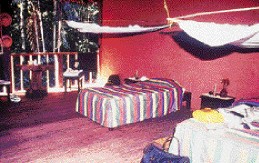 Fly east from Lima or Cuzco to Puerto
Maldonado, situated at the confluence of the mighty Madre de Dios and
Tambopata Rivers. It is a bustling, tropical frontier town, and its principal
activities are gold mining, Brazil nut collecting, timber extraction,
agriculture and ecotourism.
Fly east from Lima or Cuzco to Puerto
Maldonado, situated at the confluence of the mighty Madre de Dios and
Tambopata Rivers. It is a bustling, tropical frontier town, and its principal
activities are gold mining, Brazil nut collecting, timber extraction,
agriculture and ecotourism.
Posada Amazonas, jointly operated
by Peruvians and the Ese'eja Native Community, has 24 rooms with shower/baths,
hot water. Both a naturalist and an Ese'eja Native accompany all jungle
excursions. The reserve is noted for Harpy Eagles (the world's most powerful
bird of prey), river otters, parrots, macaws, and mineral clay licks,
as well as a 35 meter tower for observation.
Photo Gallery
Room Descriptions & Photo Gallery
Opened
in 2005, this is the latest addition to Rainforest Expeditions' Tambopata
portfolio.  As
a charming 24-bedroom lodge, it is well-placed on a 200-hectare private
reserve on the buffer zone of the
As
a charming 24-bedroom lodge, it is well-placed on a 200-hectare private
reserve on the buffer zone of the 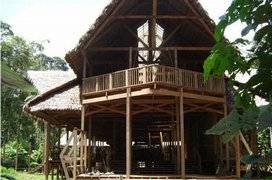 Tambopata National Reserve. Rainforest
Expeditions' Tambopata Research Center (TRC) is located deep in this reserve,
providing a unique opportunity to know the untouched, virgin forest.
Tambopata National Reserve. Rainforest
Expeditions' Tambopata Research Center (TRC) is located deep in this reserve,
providing a unique opportunity to know the untouched, virgin forest.
After
arrival in Puerto Maldonado, it is a two and a half-hour boat ride from
the Tambopata Port, passing the Tambopata National Reserve's checkpoint
and into the buffer zone of this 1.3 million hectare conservation unit.
Refugio
Amazonas has no electricity. Numerous kerosene lamps and candles provide
light. A generator is turned on once a day to recharge batteries for guests
or lodge facilities. The rooms are 7 x 4 meters so they can comfortably
hold three beds,  although
most are set up for two. The walls dividing each room are built of cane,
and extend from the floor to about 2.5 meters height making each room
private. The side that looks out to the forest does not have a wall or
screening of any kind, acting as a large window facing the forest. The
reason for this unprecedented design is because mosquitoes are not really
a problem around the lodge clearing, and the open section allows for an
intimate contact with the rainforest. A second, small window on the opposite
side, set up very high, keeps the rooms well-ventilated. Each room has
a cold water private bathroom, and rooms are not soundproof. Doors are
replaced with drapes and each room has beds, mosquito nets, bedside tables
and hammocks or lounge chairs.
although
most are set up for two. The walls dividing each room are built of cane,
and extend from the floor to about 2.5 meters height making each room
private. The side that looks out to the forest does not have a wall or
screening of any kind, acting as a large window facing the forest. The
reason for this unprecedented design is because mosquitoes are not really
a problem around the lodge clearing, and the open section allows for an
intimate contact with the rainforest. A second, small window on the opposite
side, set up very high, keeps the rooms well-ventilated. Each room has
a cold water private bathroom, and rooms are not soundproof. Doors are
replaced with drapes and each room has beds, mosquito nets, bedside tables
and hammocks or lounge chairs.
|
The remote Tambopata Research
Center lies several more hours journey by boat from Posada Amazonas,
and adjoins the Tambopata Candano Reserved Zone.
|
|
|
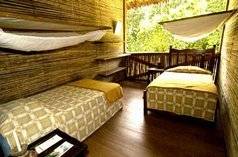 There are 13 rustic yet comfortable rooms with mosquito netting and
community bath facilities. Primarily a
research center, guests are a welcome vehicle for researchers to show off
the largest known macaw clay lick (see
below), over 25 macaw nesting sites,
There are 13 rustic yet comfortable rooms with mosquito netting and
community bath facilities. Primarily a
research center, guests are a welcome vehicle for researchers to show off
the largest known macaw clay lick (see
below), over 25 macaw nesting sites, 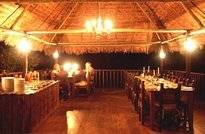 and
some of the largest bird populations in the tropics. The January 1994 issue of National Geographic
features an article on the Research Center.
and
some of the largest bird populations in the tropics. The January 1994 issue of National Geographic
features an article on the Research Center.
The Tambopata
Reserve encompasses 700,000 hectares of uninhabited wilderness
about the size of Connecticut (or Switzerland), and protects stable populations
of some of the most unique and endangered wildlife. The small scale of
its infrastructure, and the presence of researchers and naturalist guides,
provide the discerning and adventuresome traveler an excellent headquarters
for in-depth explorations of Amazonian nature and wildlife
Day 1: Arrive Puerto Maldonado Transfer from your Lima or Cuzco hotel to the airport for a short flight
to Puerto Maldonado. Meeting service
upon arrival by a representative of Rainforest Expeditions. After a brief
survey of this frontier town, you depart on the two-hour trip via motorized
dugout canoe to Posada Amazonas Lodge located on the lower Tambopata River.
Here you will have a short orientation and briefing on the lodge and the Ese'eja Ecotourism Project. (L, D)

Day 2: At Posada Amazonas After an early breakfast, depart for a visit to the beautiful Tres
Chimbadas Lake, fifteen minutes from Posada Amazonas. Take a short
trail hike to the lake and a long, easy canoe ride around it, looking
for river otters, turtles, hoatzin (left), and wading birds. Return to
the lodge around mid-morning to hike trails in primary floodplain forest
— the stereotypical rainforest. The hikes are accompanied by an Ese'eja
native who will explain how the forest is used in their everyday life.
The afternoon includes a walk to the nearest and most active of eight
harpy eagle nests found in the area. (B, L, D)
Day 3: Depart Puerto Maldonado Morning transfer back to Puerto Maldonado for your return flight to Cuzco or Lima. Transfer to your hotel. (Hotel
accommodations not included.) (B)
4 Days/3 Nights
Day 1: Arrive Puerto Maldonado Same as Itinerary I above. (L, D)
Day 2: At Posada Amazonas/Refugio
Amazonas Same as Itinerary I above. (B, L, D)
Day 3: At Posada Amazonas/Refugio
Amazonas Additional jungle excursions accompanied by an Ese'eja
native guide. (B, L, D)
Day 4: Depart Puerto Maldonado Same as Day 3 of Itinerary I above. (B)
5 Days/4 Nights
Day 1: Arrive Puerto Maldonado Same as Itinerary I above. (L, D)
Day
2: At Posada Amazonas/Refugio Amazonas Same as Itinerary I above.
(B, L, D)
 Day 3: To Tambopata Research
Center After an optional pre-breakfast outing to observe the wildlife
at peak time, travel four hours up the Tambopata
River (left) into the heart of the reserve. The final traces of
human habitation will fall away as you cross the northern boundary of
the reserve, and you will enjoy excellent wildlife viewing along the way.
Your mid-morning arrival at the center is greeted by the "Chicos," a flock
of semi-wild, rescued macaws. After lunch hike the 1.5 mile Bamboo
Trail, famous for its abundance of rare birds endemic exclusively
to this habitat.
Day 3: To Tambopata Research
Center After an optional pre-breakfast outing to observe the wildlife
at peak time, travel four hours up the Tambopata
River (left) into the heart of the reserve. The final traces of
human habitation will fall away as you cross the northern boundary of
the reserve, and you will enjoy excellent wildlife viewing along the way.
Your mid-morning arrival at the center is greeted by the "Chicos," a flock
of semi-wild, rescued macaws. After lunch hike the 1.5 mile Bamboo
Trail, famous for its abundance of rare birds endemic exclusively
to this habitat. 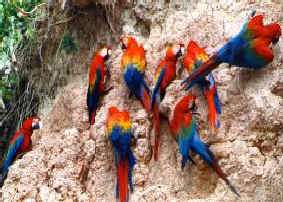 Your
hike is punctuated by the calls of Howler and Dusky-headed titi monkeys.
After dinner enjoy a slide show presentation of the research projects
past and present, followed by a short night walk along the beach looking
for caiman. (B, L, D)
Your
hike is punctuated by the calls of Howler and Dusky-headed titi monkeys.
After dinner enjoy a slide show presentation of the research projects
past and present, followed by a short night walk along the beach looking
for caiman. (B, L, D)
Day 4: At Tambopata Research
Center At dawn visit the world's largest
macaw clay lick (right) where up to 15 species of parrots and macaws
numbering in the hundreds congregate daily. After breakfast you will hike
the 1.5 mile Ocelot Trail. Saddleback
tamarins, Squirrel and Brown Capuchin monkeys make the huge Ceiba trees
their home. After dinner, embark on a fascinating "frog
walk." (B, L, D)
Day 5: Depart
Puerto Maldonado Same as Day 3 of Itinerary I above. (B)
Safaris include: Round-trip airfare Cuzco to Puerto Maldonado, round-trip airport
transfers in Puerto Maldonado, all meals, bottled water and non-alcoholic
juice, nature trails, and your choice of excursions.
Not included: Soft drinks,
alcoholic beverages, gratuities and airport tax.
Note: These packages are priced as extensions to one of the Peru programs
from Cuzco. If originating in Lima, additional charges will apply. |
|
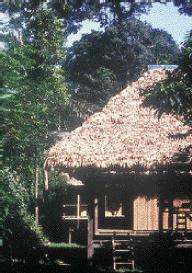
Tambopata Research Center |


